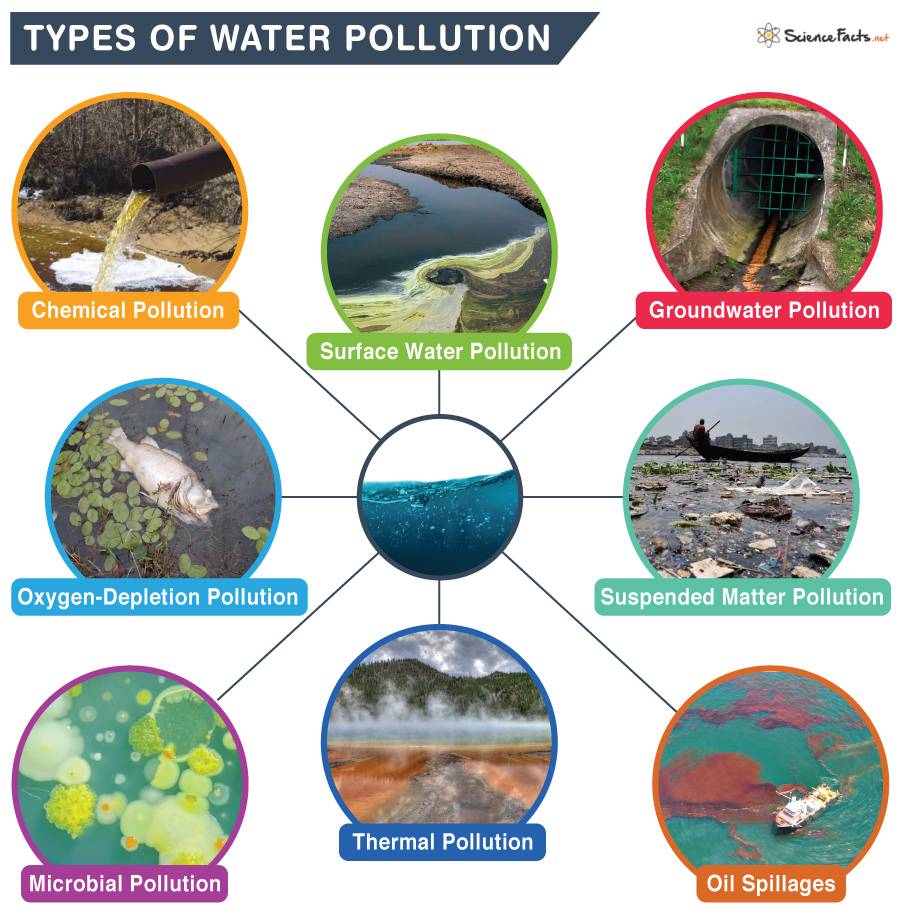Generally, water pollution can happen from either point or non-point sources. When contamination originates from a single source, it is called point source pollution. Wastewater discharge into the bodies is an example of such type of pollution. In contrast, non-point source of pollution, like agricultural runoff, occurs from diffuse sources. However, water pollution on Earth is broadly grouped into the following types:
1. Chemical Pollution
2. Surface Water Pollution
3. Groundwater Pollution
4. Suspended Matter Pollution
5. Oil Spillages
6. Thermal Pollution
7. Microbial Pollution
8. Oxygen-Depletion Pollution
Effects of Water Pollution
Effluents from the agricultural industries and metal factories also contribute significantly to water pollution. It occurs naturally by flooding or during tsunamis that pick up contaminants like fertilizers, pesticides, and debris. Sometimes it also happens accidentally by oil spills or agricultural runoffs and a few intentionally by human activities. Groundwater also becomes contaminated when landfills and septic systems leach into the ground, thus compromising water quality, which is often extracted from wells or boreholes for drinking purposes. As the suspended particles break down into minor particulate matter, they leach out toxic chemicals, which prevent oxygen and sunlight from penetrating the water bodies. Once oil enters the water, it quickly spreads over the surface, which acts like a blanket, preventing sunlight and oxygen from reaching the plants. Thus, plants cannot photosynthesize, and animals feel suffocated due to a lack of oxygen. Oil spillage also smothers the feathers of seabirds and thus prevents them from flying. The cooling discharge from thermal power plants is the primary source of thermal pollution in water bodies. This type of water pollution occurs when untreated water from households, industries, and agriculture runoff into the nearby water bodies making them suitable for the growth and survival of the microorganisms. Humans are most sensitive to this type of pollution. The depletion of oxygen in the water bodies kills aerobic organisms. In contrast, anaerobic animals thrive in such environments by producing ammonia, sulfides, and other harmful toxins, which can make the water even unfit for the survival of regular aquatic animals.
Effects on Human Health
Adding contaminants to water bodies has affected human health in several ways. According to the World Health Organization (WHO) report in 2019, almost 785 million people lack access to essential drinking water. Water pollution is the primary cause of diseases in humans. WHO recorded almost 120,000 cholera-related deaths annually. Also, the prevalence of thyroid cancer in exposed infants increased by nearly 70% after the Fukushima tragedy. Also, heavy metal accumulation can cause many health issues, such as cancer and human hormone disruption. Health issues like hepatitis, skin rashes and respiratory infections are also attributed to water pollution.
Death of Aquatic Life
Aquatic plants and animals are the groups most affected by polluted water. When water pollution causes algal bloom, it creates dead zones, which starve organisms of oxygen, causing their death. Chemicals and heavy metal pollution reduce the reproducing ability of aquatic animals and thus pose a threat of extinction. According to the data obtained from the Center for Biological Diversity, the 2010 oil spill on the Gulf of Mexico harmed over 82,000 birds, 25,900 marine animals, 6165 sea turtles, and many fish populations.
Disruption of the Food Chain
The introduction of pollutants and their biomagnifications at each level of the food chain causes poisoning and death of organisms at different trophic levels. In some cases, an entire population of a particular trophic level is wiped out, causing excessive growth of the organisms in the previous trophic level and their elimination in the following group(s).
Economic Effects
With water pollution, the availability and supply of clean drinking water shortage become a significant issue. In such cases, contaminated water is treated, purified, and made fit for drinking purposes. It increases the cost of livelihood. Also, water-borne diseases can spread rapidly, causing epidemic or pandemic-like situations. It causes death, thus adversely affecting the balance of the ecosystem.
